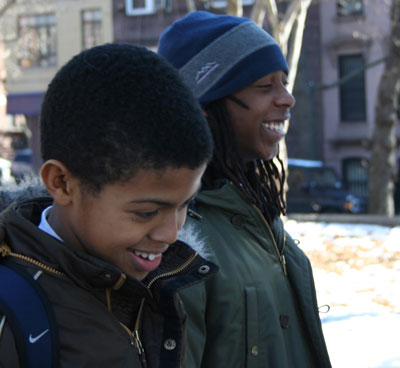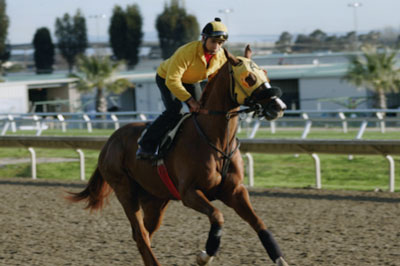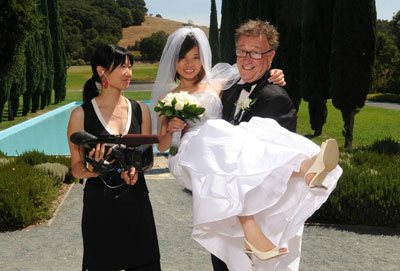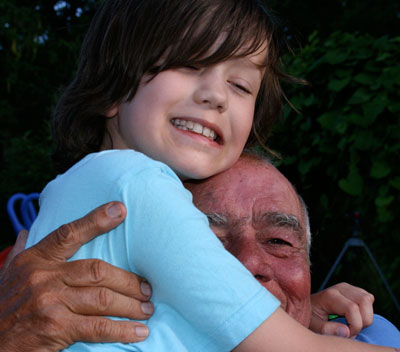American Promise spans 13 years as Joe Brewster and Michèle Stephenson, middle-class African-American parents in Brooklyn, N.Y., turn their cameras on their son, Idris, and his best friend, Seun, who make their way through one of the most prestigious private schools in the country. Chronicling the boys’ divergent paths from kindergarten through high school graduation at Manhattan’s Dalton School, this provocative, intimate documentary presents complicated truths about America’s struggle to come of age on issues of race, class and opportunity. An Official Selection of the 2013 Sundance Film Festival.
Summary info for schedule – will be hidden on film page

American Promise
135-minutes
Filmmakers Joe Brewster and Michèle Stephenson follow their son and his best friend through the U.S. educational system. Though both boys start out at the prestigious Dalton School, circumstances later force one into a public high school.
Screening day / time
Check Back Soon
American Promise
Filmmaker(s)
Filmmaker info pending
Running Time
135 minutes
American Promise
Filmmaker Notes:
PRELUDE
American Promise was conceived during our search for a school for our son. Idris was about to enter kindergarten and we had begun the difficult task of finding a school in the public school system. So after beginning the search we noted that even in the public school system, schools that were highly esteemed were segregated. This segregation came in the form of 4gifted classes, zoning requirements and the ability and know-how to push for transfers into the most prized academic public schools in more affluent and predominantly white school districts. After several attempts to meet with public school officials in combination with a rising anxiety about the quality of a New York City public education, we decided to open the process to include private independent schools. So we entered the grueling right of passage into the New York City independent school application process. We had no knowledge of what schools were out there but we were confident that we would encounter some of the best schools in the country for our son.
Many interviews and tours later, we learned of the ambitious program at The Dalton School that, in addition to a top notch education, would give their child access to privilege and opportunity that is almost unheard of for the average American student of whatever ethnic or racial background. And they made us a promise that the public school system did not seem to be keeping; they would make the institution mirror the racial makeup of the city of New York. In exchange, we would agree to a daily 60 minute commute from our home in the Fort Greene section of Brooklyn. This was a situation we could not turn down.
THE DALTON EXPERIMENT – The Lower School Years
In 1996, our first narrative film, The Keeper received a warm reception both nationally and internationally. When our son started kindergarten, we were in the midst of developing projects, caught in the never-ending cycle of grant applications and rejections and were simultaneously searching for other film project jobs for hire as producers and/or directors. Unable to find a full time project where everything came together, wherein we could be passionate about the subject matter, creatively stimulated and financially compensated, we had some time on our hands to pick up a camera on our own. We were itching to sink our teeth into something. While dreaming about the potential outcome of Idris’s education and exposure, we realized about three months into his kindergarten year that documenting his experience would be incredible. We had seen and been moved by Michael Apted’s 7-Up documentary and thought the documentation of our son’s experience would be amazing. So we set out to follow our son’s class for the next 13 years. By December 1999, we had extended our documentary experiment to include other families. Three other sets of parents of girls in the class agreed to participate in the telling of this story, where our children would be educated in a rigorous educational institution committed to a culturally diverse environment. This diversity experiment had begun to be documented. As documentary filmmakers, our main concern was access. We needed to be able to shoot in the school and in the homes of the children and as one would expect we began shooting more of the children of the parents we knew best. These children, looking back 13 years, happened to be children of families living outside of the neighborhood where the Dalton School was located. A second concern was the frequency of the filming. We initially thought that we would check in with these families twice yearly. As we began to embrace a direct cinema approach to the filmmaking, which seemed more exciting to us, we increased the frequency of shooting. But over the next four years, three of the families we started off with made the decision to remove their daughters from the project. While their decision to drop from the project seemed like huge setbacks at the time, their decision would ultimately serve to bolster our access and process, and liberate our story. What started out thinking the film could be a survey of 5 children, an important experiment of diversity, became a more intimate study of the educational journey of two African American boys and by default their families.
AMERICAN PROMISE – The Middle School Years
We cannot pinpoint exactly when we made the title switch from The Dalton Experiment to American Promise, yet we know it occurred some time during the early part of the middle school years, the most awkward and difficult period for children, including Idris and Seun. While the project continued to be embraced by the teachers, administrators, we began to experience some hesitancy on the part of some parents including the Summers family. Seun had begun to struggle in school and our access was being severely limited. We worried that they would become the fourth casualty and were preparing ourselves to go it alone, while simultaneously working with the Summers family to keep them on board. We shot at home with greater intimacy to compensate for resistance elsewhere. It was then that we began to realize that the project would have greater resonance, the more intimate and vulnerable we were in front of the camera. The artistic source for that inspiration came more from Steve James school of thought and the work at Kartemquin Films. We began to shoot sequential periods of two to three days without an event or goal in mind. We embraced a more observational filmmaking process and once we began to look at our footage, we realized that we had captured powerful moments of day-to-day family life and the pressures of education performance on both parents and boys.
Middle School was a painful time for our son and Seun. Their bodies changed, they struggled to fit in everywhere and this obviously impacted their academic achievement as well. Some of these experiences were universal to all middle school pre-adolescents. But Idris and Seun also experienced deep challenges specific to African American boys coming of age in American society. And we were intent on documenting that experience as much as we could. As our project began to have more focus on the African American male experience, we were able to make stronger more successful arguments in our fundraising endeavors. The importance of the issues and experiences we were documenting began to resonate with the funding world. For the first time in 2006, we began to receive support for our work. We received a grant from NYSCA and NBPC that allowed us to occasionally hire cinematographers and develop our trailer. Our shooting style instantly benefited. We were no longer experiencing the pain of wearing three hats – shooter, director, and parent. We were partially liberated from that burden. The trailer, however, may have been one of the most significant and pivotal developments in the making of this film. Yes, the trailer allowed us to raise money but, more importantly, it seemed to touch a personal chord with regard to the national conversation on race, class and education for African American boys. African-American families from around the country began contacting us with concerns about their own son’s performance in school, concerns that were uncanny in their resemblance to the problems we were facing with Idris. At this point, we began to realize that American Promise had an audience and maybe even a mission.
PROMISES KEPT – The High School Years
In the high school years camera technology took a leap forward as well as our funding situation. As the boys hit 10th grade we began to experiment with HD cameras and digital shooting on cards. Tape began its road to obsolescence. Also, as was to be expected, the boys began to be more resistant to our shooting. They were on their way to becoming men, and with that came the drive to be independent of parental control and oversight, and in our case that meant away from the camera and our filmmaking demands. We strategized about how best to capture the honest moments with these boys as they began to see us as parents and as the enemy. We decided to hire younger male shooters closer to them in age and disposition. We think it worked. We would send the shooter off with them for long stretches and they all became comfortable with the camera and bonded. This was the key to keeping the boys in our story arc through the four years of high school.
The choice of shooter was just one element that highlighted the essential role that trust played when it came to our subjects. Not only did we have to commit to exposing our own vulnerabilities in front of the camera, but we had to convince our subjects to keep trusting us, especially if we wanted to capture life as it happened or be there for deeply personal and intimate moments that would serve to expose kernals of our common humanity that audiences would be able to immediately relate to – and that could transcend socially constructed identities. In our case we wanted to make sure our subjects understood that we were not so much looking for an objective truth, or interested in gotcha journalism, but rather we were invested in telling a story with deeply complex characters, family life and how race and class over the years played into how life choices are made.
Our relationships were tested on numerous occasions, throughout high school especially. We had become friends with the Summers – a bond that at times, in much the same way our parent hat came up, interfered with our filmmaker story-driven objectives. At times we had to trust our instinct to put the camera down when we knew we might regret it in the edit room, and wait for the best strategic moment to pick it up, that would not jeopardize our relationships. We could only do this by trusting in the integrity of our longitudinal approach – we had to believe that the shear breadth of material we had already accumulated would work for us in the edit room and we did not and could not put our friendship in jeopardy for the sake of shooting one particular tragic scene. Our friendship had to take priority. These were very difficult calls for us. We agonized over whether to cover what could seem as going too far. But, ultimately, the bond and trust we had built over the years allowed us to access intimate moments with little resistance — that even surprised us.
The high school years were the most difficult with the school institutions, because the stakes were higher perhaps. Every start of the school year we persisted, presenting our wish list of what we wanted to shoot and negotiating access, as we relied on the notion that the schools would keep their promise to stay involved in the project until graduation.
POST-PRODUCTION – The Pain of Wearing Multiple Hats
Obviously when we as filmmakers have over 800 hours of footage, decisions made there could push the film in dramatically different directions. In 2009, we starting editing periodically with Geeta Gandbhir and Andrew Siwoff after we were honored with a production grant by the Ford Foundation. As directors this was an extremely painful process for us. We were for the first time combing through our family’s past looking at past mistakes and stumbles while trying to make decisions which impacted story structure, and character development. The scenes were strong but we had so much footage we would be editing until 2015, if we didn’t pick up the pace. We knew that we would need additional editors to help and because of the highly emotional nature of directors as parent and lead character we chose to select the strongest verite editors available to us. In January of 2012, we were lucky to bring on master verite editor Mary Mandhart (Racing Dreams) and Erin Casper (Our School). After six months of fighting, pain and tears, we assembled 33 hours of an exclusively verité driven cut of the film. By July 2012, we only needed to make a million more decisions and cut the film by 30 more hours. Tension in the edit room built up as we got closer to a final cut, as we all became deeply invested in our favorite scenes and moments. We probably left another 10 films on the cutting room floor that will find a life in this new world of transmedia storytelling, social media engagement and web presence. We are grateful to be able to have the opportunity repurpose footage that in an earlier period would never have seen the light of day.




